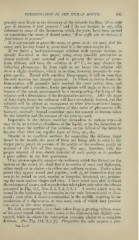Page 791 - My FlipBook
P. 791
FERMENTATION IN THE HUMAN MOUTH —
801
priority over Kocli in the discovery of the tubercle bacilkis, "11 ne siuffit
pas de trouver, il faut prouver;" and I do not hesitate to say, with
reference to some of the discussions which for years have been carried
on concerning the cause of dental caries, "11 ne sivffit pas de deviner, il
faut trouver et prouver,'^
It is not enough to guess the cause, or guess at it : we must find the
cause, and, having found it, prove that it is the cause sought for.
If we infect a beef-extract-sugar solution with carious dentine, as
already described in this paper, using every possible precaution to
obtain perfectly pure material and to prevent the access of germs
from without, and keep the solution at 37° C, we may observe the
following phenomena : In from eight to ten hours the solution will
show a slight cloudiness, which at no time, however, amounts to com-
plete opacity. Tested with sensitive litmus-paper, it will be seen that
the acid reaction has already appeared. In fifteen to twenty hours the
fermentation will generally have reached the most active state, and
soon afterward a colorless, flocky precipitate will begin to form on the
bottom of the vessel, accompanied by a corresponding clarifying of the
solution and a diminution of the feriuentative activity. After the lapse
of forty-eight hours the sediment will have completely formed, and the
solution will be almost as transparent as when the experiment began.
The time required for the completion of this series of phenomena will,
however, naturally depend somewhat upon the amount of dentine taken
for the infection and the amount of the solution used.
Impurities in the culture manifest themselves in various ways it
may be by an excessive cloudiness of the liquid, or by the formation of
a skin upon the surface of the solution, or the failure of the latter tO'
become clear after the regular lapse of time, etc., etc.
Dentine is an excellent medium for separating the different fungi-
found in the mouth, the most of them not being able to exist in the
deeper parts, partly on account of the acidity of the medium, partly on'
account of the lack of free oxygen. We may, therefore, with the
proper amount of care, obtain material of such purity as to produce
a pure culture in the first generation.
If we microscopically examine the sediment which has formed on the
bottom of the vessel, we shall find it to consist of cocci and diplococci,
either single or in chains—in either case, without motion. Under a low
power they appear round and regular ; with -^ oil immersion they are
seen to be round or oval, regular or irregular, involuted, etc., present-
ing the most various shapes and sizes. I have never been able to detect
the existence of spores, and reproduction takes place only after the scheme
presented in Fig. 411, Nos. 1, 2, 3, 4, 5, 6, 7. A coccus which may be
round in the beginning by extension in one axis becomes oval or elon-
gated ; soon after, it shows a contraction in the middle, resulting in the
production of a diplococcus or two cocci, each of which may produce
two cocci in the same manner.
We find, consequently, in a chain taken from a growing culture, some
of the cocci round, others oval ; some of the diplococci but slightly con-
tracted, while in others the contraction amounts almost to a complete
division. (See Fig. 411, d, e,f.) Frequently the cells acquire a pro-
VoL. I.—51


